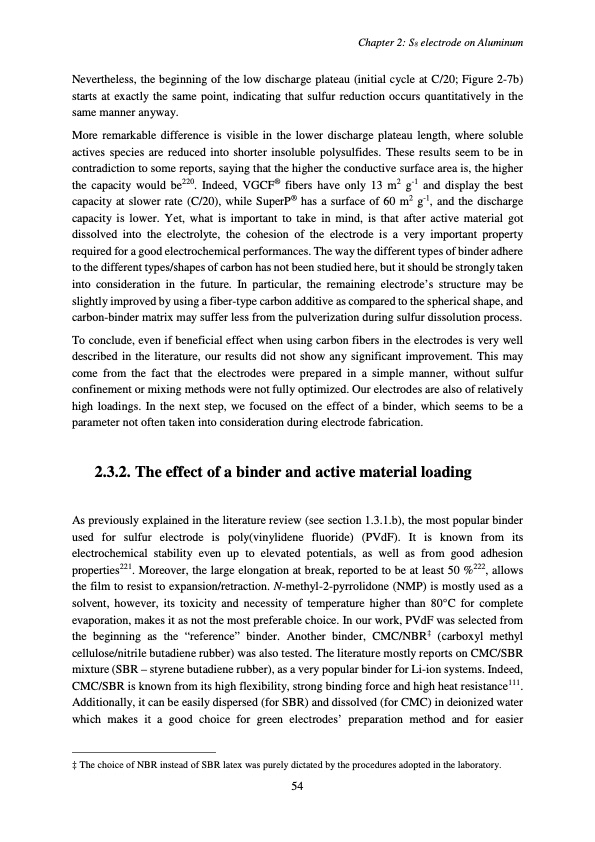
PDF Publication Title:
Text from PDF Page: 058
Nevertheless, the beginning of the low discharge plateau (initial cycle at C/20; Figure 2-7b) starts at exactly the same point, indicating that sulfur reduction occurs quantitatively in the same manner anyway. More remarkable difference is visible in the lower discharge plateau length, where soluble actives species are reduced into shorter insoluble polysulfides. These results seem to be in contradiction to some reports, saying that the higher the conductive surface area is, the higher the capacity would be220. Indeed, VGCF® fibers have only 13 m2 g-1 and display the best capacity at slower rate (C/20), while SuperP® has a surface of 60 m2 g-1, and the discharge capacity is lower. Yet, what is important to take in mind, is that after active material got dissolved into the electrolyte, the cohesion of the electrode is a very important property required for a good electrochemical performances. The way the different types of binder adhere to the different types/shapes of carbon has not been studied here, but it should be strongly taken into consideration in the future. In particular, the remaining electrode’s structure may be slightly improved by using a fiber-type carbon additive as compared to the spherical shape, and carbon-binder matrix may suffer less from the pulverization during sulfur dissolution process. To conclude, even if beneficial effect when using carbon fibers in the electrodes is very well described in the literature, our results did not show any significant improvement. This may come from the fact that the electrodes were prepared in a simple manner, without sulfur confinement or mixing methods were not fully optimized. Our electrodes are also of relatively high loadings. In the next step, we focused on the effect of a binder, which seems to be a parameter not often taken into consideration during electrode fabrication. 2.3.2. The effect of a binder and active material loading As previously explained in the literature review (see section 1.3.1.b), the most popular binder used for sulfur electrode is poly(vinylidene fluoride) (PVdF). It is known from its electrochemical stability even up to elevated potentials, as well as from good adhesion properties221. Moreover, the large elongation at break, reported to be at least 50 %222, allows the film to resist to expansion/retraction. N-methyl-2-pyrrolidone (NMP) is mostly used as a solvent, however, its toxicity and necessity of temperature higher than 80°C for complete evaporation, makes it as not the most preferable choice. In our work, PVdF was selected from the beginning as the “reference” binder. Another binder, CMC/NBR‡ (carboxyl methyl cellulose/nitrile butadiene rubber) was also tested. The literature mostly reports on CMC/SBR mixture (SBR – styrene butadiene rubber), as a very popular binder for Li-ion systems. Indeed, CMC/SBR is known from its high flexibility, strong binding force and high heat resistance111. Additionally, it can be easily dispersed (for SBR) and dissolved (for CMC) in deionized water which makes it a good choice for green electrodes’ preparation method and for easier ‡ The choice of NBR instead of SBR latex was purely dictated by the procedures adopted in the laboratory. 54 Chapter 2: S8 electrode on AluminumPDF Image | Accumulateur Lithium Soufre

PDF Search Title:
Accumulateur Lithium SoufreOriginal File Name Searched:
WALUS_2015_archivage.pdfDIY PDF Search: Google It | Yahoo | Bing
Sulfur Deposition on Carbon Nanofibers using Supercritical CO2 Sulfur Deposition on Carbon Nanofibers using Supercritical CO2. Gamma sulfur also known as mother of pearl sulfur and nacreous sulfur... More Info
CO2 Organic Rankine Cycle Experimenter Platform The supercritical CO2 phase change system is both a heat pump and organic rankine cycle which can be used for those purposes and as a supercritical extractor for advanced subcritical and supercritical extraction technology. Uses include producing nanoparticles, precious metal CO2 extraction, lithium battery recycling, and other applications... More Info
| CONTACT TEL: 608-238-6001 Email: greg@infinityturbine.com | RSS | AMP |